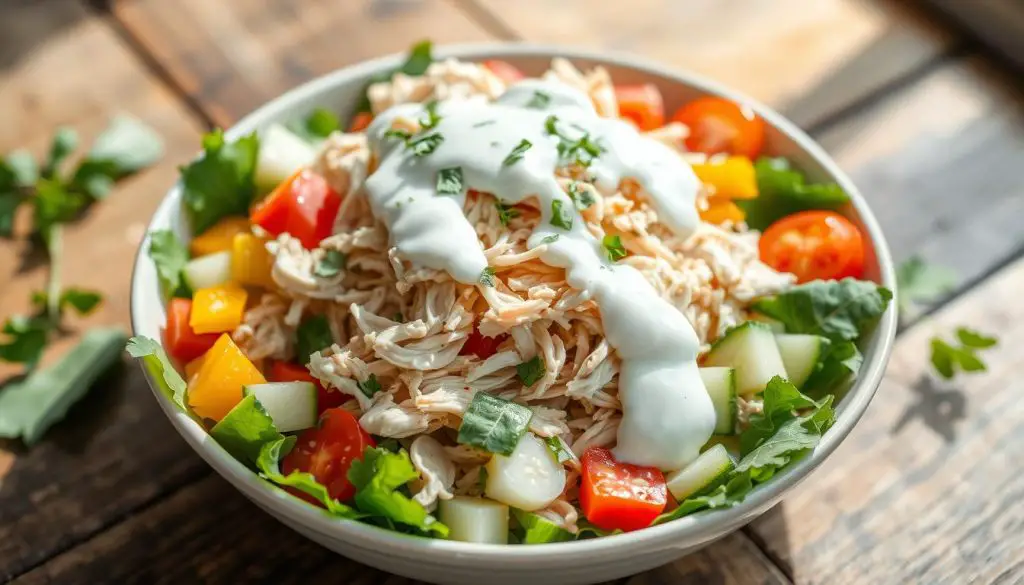Could a simple diet change help ease your fibromyalgia symptoms? The Arthritis Foundation says fibromyalgia affects over 3.7 million Americans. It’s a widespread and debilitating condition. But, what if removing dairy from your diet could boost your energy, improve daily activities, and lessen chronic pain?
Intrigued? Read on to learn how this chicken salad with lactose-free yogurt dressing can change your fibromyalgia management.
Recent studies show most fibromyalgia patients struggle with lactic acid processing. This can cause muscle pain and fatigue after exertion. Also, many fibromyalgia patients lack vitamin D, which worsens symptoms.
Learn more about diet and fibromyalgia to manage your condition better.
Understanding Fibromyalgia and Diet
Fibromyalgia is a chronic condition that causes widespread muscle pain, fatigue, and sleep issues. It also leads to depression. While we don’t know the exact cause, diet may help manage its symptoms.
Fibromyalgia: A Chronic Condition
Fibromyalgia affects about 5 million American adults. It brings chronic pain, sleep problems, and mood issues. To manage it, we need medical treatment, lifestyle changes, and diet.
Dietary Approaches for Fibromyalgia
Several diets may help with fibromyalgia symptoms. Some promising ones include:
- Low-calorie diets: They can improve pain, fatigue, and quality of life for those with fibromyalgia.
- Vegetarian diets: A 2019 review found they may reduce pain, improve sleep, and boost mood.
- Low-FODMAP diets: A 2017 study showed they can ease symptoms and enhance life quality for fibromyalgia patients.
Also, avoiding excitotoxins like MSG and aspartame might help. Eating a balanced diet and fixing vitamin and mineral deficiencies, like vitamin D and B12, is also key.
Understanding diet’s role in managing fibromyalgia is important. By exploring different diets, people with fibromyalgia can work with their doctors to create a personalized plan. This plan will address their specific needs and symptoms.
Anti-Inflammatory Foods to Include
To manage fibromyalgia symptoms, add anti-inflammatory foods to your diet. These foods are packed with nutrients. They help reduce inflammation, easing your symptoms and improving your health.
Protein-Rich Options
Protein-rich foods like salmon, eggs, chickpeas, and Greek yogurt help repair muscles. They support muscle function. Adding these to your diet can be very helpful.
Fruits and Vegetables
Eat lots of fruits and vegetables, like spinach, kale, berries, and tomatoes. They’re full of antioxidants and vitamins. These help fight inflammation.
Carbohydrates and Fats
Complex carbs from sweet potatoes, brown rice, and honey are good. So are healthy fats from olive oil and coconut oil. They’re great for fibromyalgia sufferers.
By adding these anti-inflammatory foods to your diet, you can make a balanced fibromyalgia diet. This diet supports your health and may ease your symptoms.
Foods to Avoid for Fibromyalgia
It’s key to eat foods that fight inflammation if you have fibromyalgia. But, you should also avoid certain foods that can make your symptoms worse. These include processed foods, refined carbs, fast food, and pro-inflammatory oils. Also, foods high in FODMAPs like wheat, dairy, and beans are bad for those on a low-FODMAP diet.
Studies show that 42% of fibromyalgia patients say their symptoms get worse after eating certain foods. Another study found that 84% of patients felt better by avoiding MSG and aspartame.
- Processed and refined carbs can make inflammation worse and hurt fibromyalgia symptoms.
- Stay away from artificial sweeteners like aspartame, acesulfame-K, saccharin, and sucralose. They can lead to weight gain, diabetes, and more inflammation.
- Vegetables like tomatoes, potatoes, eggplants, and peppers might bother some people with fibromyalgia.
Keeping a food diary can help you find out what foods make you feel bad. It lets you change your diet to feel better. Talking to a registered dietitian is also a good idea. They can help you figure out which foods to avoid and find the best diet for you.
| Food Group | Examples | Potential Impact on Fibromyalgia |
|---|---|---|
| Processed Foods | Chips, cookies, fast food, frozen meals | Can increase inflammation and exacerbate symptoms |
| Refined Carbohydrates | White bread, pasta, rice, baked goods | May contribute to blood sugar spikes and inflammation |
| Artificial Sweeteners | Aspartame, saccharin, sucralose | Can lead to weight gain, metabolic issues, and further inflammation |
| Nightshade Vegetables | Tomatoes, potatoes, eggplants, peppers | May irritate some individuals with fibromyalgia |
Chicken salad with lactose-free yogurt for fibromyalgia
If you have fibromyalgia, try this dairy-free chicken salad. It’s full of anti-inflammatory foods like lean protein, fruits, and veggies. This meal not only feeds your body but also helps with fibromyalgia symptoms.
The secret ingredient is lactose-free yogurt in the dressing. Many with fibromyalgia can’t handle dairy. The yogurt’s probiotics support gut health, which is key for those with autoimmune issues. Choosing lactose-free yogurt means you get a creamy dressing without stomach trouble.
This chicken salad with lactose-free yogurt is great on its own or on greens. It’s also perfect as a protein-rich topping for crackers or low-lactose bread. Its anti-inflammatory and gut-friendly qualities make it ideal for fibromyalgia management through diet.

Adding this anti-inflammatory recipe to your diet can help manage fibromyalgia. It’s a delicious and fibromyalgia-friendly option for a balanced diet.
Benefits of a Lactose-Free Yogurt Dressing
If you have fibromyalgia, this chicken salad recipe’s lactose-free yogurt dressing is a game-changer. It’s packed with probiotics, which are key for a healthy gut.
Probiotics for Gut Health
Probiotics are live bacteria and yeasts that keep your gut balanced. Studies show they’re great for people with autoimmune disorders like fibromyalgia. They help lower inflammation and boost gut health, easing fibromyalgia symptoms.
Choosing a lactose-free yogurt dressing means you avoid dairy’s digestive issues. It also feeds your gut with probiotics. This can lead to a better gut environment, reducing pain, fatigue, and other symptoms.
Adding a lactose-free yogurt dressing to your diet is a smart move for fibromyalgia sufferers. It supports your overall health and can help manage symptoms. Learn about probiotics and how they can help you on your fibromyalgia journey.
Lean Protein Sources for Fibromyalgia
Incorporating lean protein sources into your diet is key for those with fibromyalgia. These foods are rich in protein and help repair muscles. They also support overall health, which is vital for managing fibromyalgia symptoms. Some top lean protein options include:
- Chicken
- Eggs
- Fish
- Lean grass-fed beef
Adding lean proteins to meals and snacks is easy. They provide essential amino acids for muscle repair and chronic pain management. By focusing on these proteins, you can ease symptoms and improve your health.

Remember, a balanced diet with lean proteins and anti-inflammatory foods is a strong ally. It can help you manage the challenges of fibromyalgia.
Preparing the Chicken Salad with Lactose-Free Yogurt Dressing
Ingredients
To make this tasty chicken salad recipe, you’ll need a few ingredients:
- 2 cups of cooked, shredded chicken
- 1 avocado, diced
- 1 cup of cherry tomatoes, halved
- 1/4 cup of fresh basil, chopped
- 1 cup of lactose-free yogurt
- 2 tablespoons of balsamic vinegar
- 1 tablespoon of olive oil
- Salt and pepper to taste
Instructions
To make the lactose-free yogurt dressing and put together the fibromyalgia-friendly meal, just follow these steps:
- In a medium bowl, mix the cooked chicken, avocado, cherry tomatoes, and basil.
- In another bowl, mix the lactose-free yogurt, balsamic vinegar, and olive oil until smooth.
- Pour the dressing over the chicken salad and toss gently to coat everything.
- Season with salt and pepper as needed.
- Serve the chicken salad with lactose-free yogurt dressing chilled or at room temperature. Enjoy this healthy and tasty meal.
This chicken salad recipe is not only yummy but also good for those with fibromyalgia. It has anti-inflammatory ingredients and a lactose-free dressing.
Nutritional Value of the Chicken Salad
The chicken salad with lactose-free yogurt dressing is packed with nutrients. It’s great for your health and can help with fibromyalgia symptoms. A serving has about 526 calories, 50 grams of protein, 30 grams of fat, and 17 grams of carbs.
This salad is not just tasty; it’s also full of fiber, vitamins, and minerals. The nutritional value of this dish can help those with fibromyalgia by:
- Supplying essential nutrients to support overall health and well-being
- Providing anti-inflammatory properties that may help alleviate symptoms
- Promoting better digestion and gut health with the inclusion of probiotics from the lactose-free yogurt
Adding this chicken salad to your diet can make mealtime enjoyable and healthy. It’s a great way to manage your fibromyalgia.

Incorporating the Chicken Salad into a Fibromyalgia Diet
The chicken salad with lactose-free yogurt dressing is a great choice for a fibromyalgia diet. It’s packed with nutrients and has anti-inflammatory ingredients. These can help manage fibromyalgia symptoms. The lactose-free yogurt also supports gut health, which is key for those with fibromyalgia.
Enjoy this chicken salad as a main dish or a snack. It’s full of protein and has anti-inflammatory properties. These can help with chronic pain management in fibromyalgia.
- Make the chicken salad a regular part of your meals a few times a week.
- Pair it with fresh greens or roasted veggies for a full meal.
- Use it as a topping for mixed greens or a filling for whole-grain wraps.
- It’s also great as a protein-rich snack, with whole-grain crackers or veggie sticks.
Adding the chicken salad to your fibromyalgia diet can offer anti-inflammatory benefits. It supports your overall health. Listen to your body and adjust how much you eat to meet your dietary needs and manage symptoms.
| Nutrient | Amount per Serving | % Daily Value |
|---|---|---|
| Calories | 300 kcal | 15% |
| Protein | 25 g | 50% |
| Carbohydrates | 15 g | 5% |
| Dietary Fiber | 3 g | 11% |
| Total Fat | 18 g | 28% |
| Saturated Fat | 4 g | 20% |
| Vitamin C | 20 mg | 22% |
| Calcium | 150 mg | 15% |
Tips for Modifying the Recipe
Managing fibromyalgia can be easier with recipe modifications. The chicken salad recipe can be changed to fit your diet. This makes it easier to follow your dietary needs.
If you’re on a vegetarian or vegan diet, you can swap the chicken for tofu or hard-boiled eggs. This keeps the taste great while sticking to your diet.
You can also change the dressing to your liking. Try different vinegars or add more herbs and spices. These small changes can make the recipe fit your taste and diet better.
Start exploring recipe modifications to find a dish that’s both healthy and tasty. This way, you can enjoy the chicken salad without worrying about your diet. It’s all about finding the right balance.

Customization Options to Consider
- Substitute the chicken with tofu or hard-boiled eggs for a vegetarian or vegan option
- Experiment with different types of vinegar in the dressing, such as apple cider or balsamic
- Add extra herbs and spices to the dressing to create a flavor profile that suits your preferences
- Explore alternative dairy-free options, such as cashew or almond yogurt, for the dressing
By making these simple changes, you can make the chicken salad fit your diet perfectly. It stays delicious and healthy, making it a great choice for your fibromyalgia diet.
Fibromyalgia-Friendly Meal Ideas
There are many tasty meals that are good for fibromyalgia. Try the chicken salad with lactose-free yogurt dressing for a great start. These meals help manage chronic pain and other symptoms.
For a healthy breakfast, make shakshuka with spinach and parsley. It’s full of eggs, tomatoes, and herbs that fight inflammation. Another good choice is mango turmeric overnight oats. They’re packed with fiber, vitamin C, and turmeric’s anti-inflammatory powers.
For lunch or dinner, try a watermelon and grilled cheese salad. It’s sweet and creamy, thanks to lactose-free cheese. A wild blueberry cauliflower smoothie is also great. It’s full of antioxidants and nutrients to help with fibromyalgia.
| Meal | Fibromyalgia-Friendly Dish | Key Anti-Inflammatory Ingredients |
|---|---|---|
| Breakfast | Shakshuka with Spinach and Parsley | Eggs, tomatoes, spinach, parsley |
| Breakfast | Mango Turmeric Overnight Oats | Oats, mango, turmeric |
| Lunch/Dinner | Watermelon and Grilled Cheese Salad | Watermelon, lactose-free cheese |
| Smoothie | Wild Blueberry Cauliflower Smoothie | Wild blueberries, cauliflower |
Adding these meals to your diet can help manage chronic pain. A balanced, anti-inflammatory diet is key to feeling better. It’s a big step towards a better fibromyalgia journey.
Managing Fibromyalgia Through Diet
Fibromyalgia affects about 4 million adults in the United States. There’s no cure, but a special diet can help manage symptoms. Eating anti-inflammatory foods and avoiding bad ingredients can help. This can reduce pain, fatigue, and other symptoms.
Diets like low-calorie, vegetarian, and low FODMAP have helped some people. These diets include foods like fruits, veggies, nuts, and lean proteins. They avoid processed meats, refined carbs, and artificial sweeteners. Making smart food choices can fight chronic inflammation linked to fibromyalgia.
The chicken salad with lactose-free yogurt dressing is a good example of a fibromyalgia-friendly meal. It’s packed with anti-inflammatory ingredients and supports gut health. Choosing such foods can improve your overall health and reduce fibromyalgia symptoms.
Source Links
- https://godairyfree.org/personal-stories/dairy-free-pain-free-for-me
- https://www.fibromyalgiaforums.org/community/threads/special-diet-for-fibro.21634/
- https://www.eatingwell.com/article/291150/fibromyalgia-diet-foods-you-should-eat-and-foods-you-should-avoid/
- https://www.verywellhealth.com/fibromyalgia-diet-good-and-bad-foods-4144693
- https://www.healthline.com/health/fibromyalgia-diet-to-ease-symptoms
- https://www.everydayhealth.com/fibromyalgia/diet/fibromyalgia-what-eat-what-avoid/
- https://www.lanewellness.com/about-us/services—techniques/anti-inflammatory-foods-diet.html
- https://www.healthline.com/nutrition/fibromyalgia-diet-recipes
- https://www.medicalnewstoday.com/articles/315386
- https://www.healthline.com/nutrition/lactose-free-diet
- https://www.belmarrahealth.com/fibromyalgia-diet-foods-eat-avoid-sample-meal-plan/
- https://www.confrontingchronicpain.com/your-nutrition-plan-for-chronic-pain/
- https://www.drfabio.com/antiinflammatory-diet-pyamid
- https://www.weightandwellness.com/resources/articles-and-videos/deli-detective-reports-salad-dressings
- https://nourishingmeals.com/diet/basic-elimination-diet
- https://www.nhs.uk/live-well/eat-well/how-to-eat-a-balanced-diet/eat-less-saturated-fat/
- https://www.verywellhealth.com/leaky-gut-diet-4773680
- http://ndl.ethernet.edu.et/bitstream/123456789/36842/1/3125.pdf
- https://www.healthline.com/health/rheumatoid-arthritis/seven-day-meal-plan
- https://www.healthlinkbc.ca/health-topics/modify-recipes-heart-healthy-diet
- https://sevenlayercharlotte.com/2018/11/01/notes-from-the-gluten-free-dairy-free-class/
- https://www.eatingwell.com/article/7866119/rheumatoid-arthritis-diet-plan/
- https://medmunch.com/fibromyalgia-diet-meal-plan-pdf/
